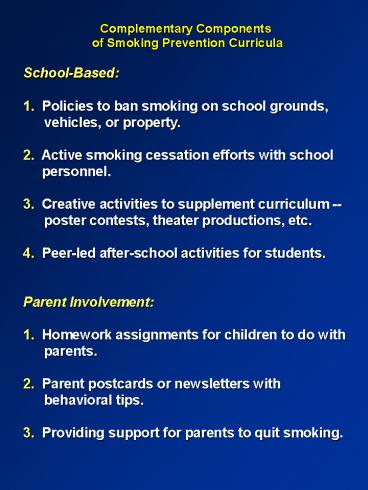Complementary Components PowerPoint PPT Presentation
1 / 4
Title: Complementary Components
1
Complementary Components of Smoking Prevention
Curricula School-Based 1. Policies to ban
smoking on school grounds, vehicles, or
property. 2. Active smoking cessation efforts
with school personnel. 3. Creative
activities to supplement curriculum -- poster
contests, theater productions, etc. 4. Peer-led
after-school activities for students. Parent
Involvement 1. Homework assignments for
children to do with parents. 2. Parent
postcards or newsletters with behavioral
tips. 3. Providing support for parents to quit
smoking.
2
Complementary Components of Smoking Prevention
Curricula (Continued) Neighborhood/Community
1. Adult action teams to examine policies and
practices related to smoking near school
grounds. 2. Removal of vending machines and
store advertising. 3. Monitoring and
supervision of after-school hang-outs for
kids. 4. Creation of after-school, weekend, and
summer programs that are smoke-free.
3
Components of Successful Smoking and Drug Use
Prevention Curricula 1. Program development
based on behavioral theory and knowledge of
predictive factors 2. Developmentally-appropria
te information about tobacco, including
information on short-term effects and long-term
consequences 3. The development of personal,
social, and resistance skills to help students
identify internal (e.g., anxiety and stress) and
external (e.g., peer pressure and advertising)
pressures to use tobacco and the skills to resist
these influences while maintaining
friendships 4. An emphasis on normative
education that reinforces that most people their
age do not use tobacco 5. Structured
broader-based skill training, for example
goal-setting, stress management, communication
skills, general social skills, and assertiveness
skills
4
Components of Successful Smoking and Drug Use
Prevention Curricula (Continued)
6. Interactive teaching techniques, for example
role playing, discussions, and peer-led small
group activities to promote active participation
of students 7. At least 6-10 sessions one
year, followed by three to five booster sessions
in at least two succeeding years 8. Teacher
training and support from program developers or
prevention experts 9. Active school-wide,
family and community involvement
Adapted from Drug Strategies, 1996 Dusenbury
Falco, 1995
10. Cultural sensitivity (e.g., includes
activities that require teacher and student input
and can be tailored to cultural experience of
classroom).

